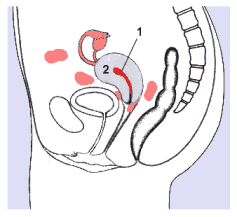|
Physical Problems in Females
|
|
Endometriosis
|
|
Endometriosis is a chronic disease caused by the spread of the uterine lining to places inside the body where it does not belong. In healthy women, this lining, called endometrium, is found only inside the uterus, where it periodically grows and breaks down and then leaves the body through the vagina in the form of menstrual blood (see The Three Phases of the Menstrual Cycle). However, when endometrial tissue grows outside the uterus, it cannot leave the body when it breaks down. The periodic internal bleeding can then lead to painful scarring, blisters, cysts and other health problems, including infertility.
The cause of endometriosis is still unknown. One theory suggests that some backing up of menstrual blood into the Fallopian tubes may cause the problem (retrograde menstruation). Another theory speculates that some toxins in the environment may be responsible or that the disease may “run in families”, i.e. that a genetic predisposition may put certain females at greater risk, and there are still other theories.
It is also unclear how many women of childbearing age are affected. Exact figures are not available. Estimates range anywhere from 10% -25%. It is certain, however, that among infertile women endometriosis is much more common than in other women.
 |
Some possible sites of endometriosis
In a healthy woman, the endometrium (1) is found only inside the uterus (2). When endometrial tissue spreads to sites outside the uterus (light red areas), one speaks of endometriosis. Most often it affects the ovaries, but it can also appear in the Fallopian tubes, on the outside surface of the uterus, in the space between the uterus and the rectum, in the cervix and the vagina, in the bladder, in the abdominal cavity, and in still other places. |